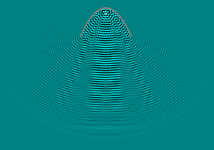I don't know why this has been said. There are subtleties in either the plane or spherical wave approach which prevent such a simple conclusion. I can't see myself prioritising plane waves unless a practical reason is discovered.The reflected wave will arrive at the soil surface as a plane wavefront, so it should penetrate the surface soil evenly.
You're using ultrasound (centimetre wavelength) with earth that is deeper than that (several cm). The ultrasound beam would easily cut through the air but lots of energy would be wasted in simply vibrating the soil particles. This could also cause disturbances to other useful birds and animals above the ground.
I thought this solution was the best, so what's wrong? It is well known that a plane wave has little attenuation, but what is wrong with this solution?I don't know why this has been said. There are subtleties in either the plane or spherical wave approach which prevent such a simple conclusion. I can't see myself prioritising plane waves unless a practical reason is discovered.
@newvirus2008 in this case the ultrasonic wave has a wavelength of 1.7 cm (20 khz) so in your opinion it couldn't penetrate the ground?
What do you mean, the reduced drop off power per distance? Irrelevant. You have a fixed target so it should be possible to put as much sound there as you like regardless.I thought this solution was the best, so what's wrong? It is well known that a plane wave has little attenuation, but what is wrong with this solution?
This also has little to do with reflection as discussed here.
@AllenB no but I have already described my constraints, I also made a small drawing to understand better. So now I propose again, an ultrasound beam that is 60 cm away from the solid, and in these 60 cm there is air, can the 20 khz ultrasound beam penetrate both the air and the ground? how much energy is reflected?
Are you planning to measure this? I would be. It will show you what's going on even when there are doubts. You'd be able to map where sound does and doesn't go, and how much.
Soil is not a consistent and homogenous medium, and a parabola will need work if you are to get a consistent plane wave, if that's important.

Soil is not a consistent and homogenous medium, and a parabola will need work if you are to get a consistent plane wave, if that's important.

@AllenB Yes, however, in the simulation image I see that many wave fronts are created. However, the idea of using the parabola came from a friend of mine who advised me this way, telling me that if the surface of the ground is rough enough there will be propagation beyond the ground. but you tell me it's not like that😥
As mentioned, the soil penetration depth is small in relation to the source distance from the surface.. so reduction in pressure over distance will be less significant of an issue in any case. (This also means plane vs spherical)
On the other hand, the speed of sound will differ in soil, changing the apparent distances.
Additionally, as you go through cycles of hydration this will change.
Have you consulted a paper like this to learn these things? - https://www.brl.uiuc.edu/Publications/2002/Oelze-SSAJ-7882002.pdf
On the other hand, the speed of sound will differ in soil, changing the apparent distances.
Additionally, as you go through cycles of hydration this will change.
Have you consulted a paper like this to learn these things? - https://www.brl.uiuc.edu/Publications/2002/Oelze-SSAJ-7882002.pdf
the affected area is approximately 3 cm,
There is obviously a communication difficulty here.
Andrew asked for an area, but was instead given a depth, the magnitude of which is already known!
@Galu yes yes even the root area is the same, anyway read this article
https://bimedis.com/latest-news/browse/460/when-ultrasound-passes-over-the-aberrant-layers
https://bimedis.com/latest-news/browse/460/when-ultrasound-passes-over-the-aberrant-layers
yes yes even the root area is the same, anyway read this article
How can an area be 3 cm? I believe Andrew was asking for the surface area of the soil that required to be 'illuminated' by the ultrasound.
I've read the article. It's about a "metamaterial" technology that will help ultrasound to penetrate bone and not just soft tissue.
The technology was at the pre-development stage at the time of publication in 2016.
- Home
- General Interest
- Everything Else
- Ultrasounds